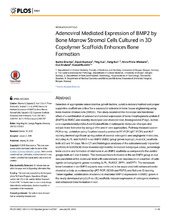Adenoviral Mediated Expression of BMP2 by Bone Marrow Stromal Cells cultured in 3D Copolymer Scaffolds Enhances Bone Formation
Sharma, Sunita; Sapkota, Dipak; Xue, Ying; Sun, Yang; Finne-Wistrand, Anna; Bruland, Ove; Mustafa, Kamal Babikeir Eln
Peer reviewed, Journal article
Published version

Åpne
Permanent lenke
https://hdl.handle.net/1956/15692Utgivelsesdato
2016-01-25Metadata
Vis full innførselSamlinger
Originalversjon
https://doi.org/10.1371/journal.pone.0147507Sammendrag
Selection of appropriate osteoinductive growth factors, suitable delivery method and proper supportive scaffold are critical for a successful outcome in bone tissue engineering using bone marrow stromal cells (BMSC). This study examined the molecular and functional effect of a combination of adenoviral mediated expression of bone morphogenetic protein-2 (BMP2) in BMSC and recently developed and characterized, biodegradable Poly(L-lactide-co-є-caprolactone){poly(LLA-co-CL)}scaffolds in osteogenic molecular changes and ectopic bone formation by using in vitro and in vivo approaches. Pathway-focused custom PCR array, validation using TaqMan based quantitative RT-PCR (qRT-PCR) and ALP staining showed significant up-regulation of several osteogenic and angiogenic molecules, including ALPL and RUNX2 in ad-BMP2 BMSC group grown in poly(LLA-co-CL) scaffolds both at 3 and 14 days. Micro CT and histological analyses of the subcutaneously implanted scaffolds in NOD/SCID mice revealed significantly increased radiopaque areas, percentage bone volume and formation of vital bone in ad-BMP2 scaffolds as compared to the control groups both at 2 and 8 weeks. The increased bone formation in the ad-BMP2 group in vivo was paralleled at the molecular level with concomitant over-expression of a number of osteogenic and angiogenic genes including ALPL, RUNX2, SPP1, ANGPT1. The increased bone formation in ad-BMP2 explants was not found to be associated with enhanced endochondral activity as evidenced by qRT-PCR (SOX9 and FGF2) and Safranin O staining. Taken together, combination of adenoviral mediated BMP-2 expression in BMSC grown in the newly developed poly(LLA-co-CL) scaffolds induced expression of osteogenic markers and enhanced bone formation in vivo.
